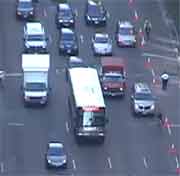
TUESDAY, July 3 (HealthDay News) — Certain new crash-avoidance systems are effective in preventing car accidents, while others may do more harm than good, researchers say.
The analysis, conducted by the nonprofit research organization Highway Loss Data Institute, found two crash-avoidance features provide the biggest benefits: autonomous breaking (the car will brake on its own if the driver doesn’t) and adaptive headlights (headlights that shift directions as a driver steers).
The researchers pointed out, however, that lane-departure warnings actually cause more accidents. Other crash-avoidance features, such as blind-spot detection and park assist, have yet to show an effect on the number of crashes, they noted.
“As more automakers offer advanced technologies on their vehicles, insurance data provides an early glimpse of how these features perform in the real world,” Matt Moore, vice president of the Highway Loss Data Institute, an affiliate of the Insurance Institute for Highway Safety, said in an insurance institute news release. “Forward collision technology is reducing claims, particularly for damage to other vehicles, and adaptive headlights are having an even bigger impact than we had anticipated.”
In conducting the study, the researchers examined how individual features of crash-avoidance systems that are offered as options on Acura, Mercedes-Benz and Volvo models affected the number of claims under various forms of insurance coverage.
After taking into account other factors that could influence claim rates, such as drivers’ age, gender and deductible, the researchers found clear patterns in claims under property damage liability insurance (damage caused by the insured vehicle) and collision insurance (damage to the insured vehicle).
One of the crash-avoidance systems the study examined was forward collision warning, which alerts a driver if the car is approaching traffic ahead too quickly. The researchers noted that some of these systems include autonomous braking.
The study revealed that the technology reduced the frequency of property damage liability claims by 14 percent on Acura and Mercedes models equipped with both forward collision warning and autonomous braking. Volvo’s autonomous-braking system reduced crashes 10 percent, a statistically insignificant decline, the investigators noted in the news release.
These systems were not meant to address claim frequency under collision coverage, yet they reduced these claims slightly, the researchers found. Some reductions in injury claims also were seen.
Mercedes and Volvo also offer versions of forward collision warning that exclude autonomous braking. These systems lowered crash rates, the study revealed, but not as much as those with both features.
The researchers suggested that the systems without autonomous braking weren’t as effective at preventing crashes because they rely on drivers to react and can’t directly avoid accidents.
Another feature the study examined was adaptive headlights, which ensure lights are directed where the vehicle is going. The researchers found that property damage liability claims fell as much as 10 percent on Acura, Mazda, Mercedes and Volvo models equipped with this feature. The study also found injury claims fell substantially for all but one of the brands examined.
“All four adaptive-headlight systems we looked at show benefits for most insurance coverages, and many of these estimated reductions are statistically significant,” Moore said. “These lights appear to help in more situations than we anticipated, though we don’t yet know why.”
In contrast, lane-departure warning systems from Buick and Mercedes increased claim rates under collision and property damage liability coverages. The increases, however, were not statistically significant, the researchers pointed out.
The researchers noted that the benefit of this feature may not have been realized yet because drifting off the road is not common. The study authors also suggested that because the technology relies on cameras to track lane markings it may not be effective unless markings are clearly visible.
“Lane-departure warning may end up saving lives down the road, but so far these particular versions aren’t preventing insurance claims,” Moore said. “It may be that drivers are getting too many false alarms, which could make them tune out the warnings or turn them off completely.”
Lane-departure systems that would force a vehicle to stay in its lane have not yet been examined, the researchers noted. This crash-avoidance feature, they said, could have a different impact on claims than lane-departure warnings.
“Just as forward collision warning systems that include autonomous braking cut crashes more sharply than those that don’t, lane-departure prevention systems that don’t rely on a driver’s response may hold more promise than the systems [Highway Loss Data Institute] has looked at so far,” David Zuby, chief research officer at the Insurance Institute for Highway Safety, said in the news release.
More information
The U.S. National Highway Traffic Safety Administration has more about driving safety.

